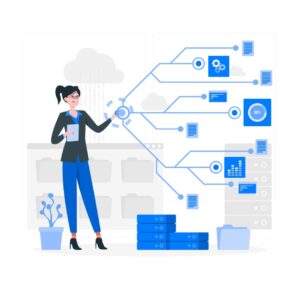Migrating Data from Your Legacy Solution to Acumatica Cloud ERP
The transition from legacy on-premises systems to a new ERP system like Acumatica Cloud ERP offers numerous benefits, including enhanced productivity, improved data accuracy, and better security. It’s a complex process that requires good planning to avoid failure and maximize the return on your technology investment.
Among the many phases of a well-executed ERP implementation is Data Migration. This phase ensures all the work you’ve done in the past remains available for reporting, long-term business insights, and to help you hit the ground running in your new solution. We’ll discuss the data migration process and how Acumatica eases these transitions.
Acumatica Cloud ERP: Benefits of the Transition
Migrating business data to a new ERP (Enterprise Resource Planning) solution can bring several key benefits to an organization:
- Enhanced Efficiency and Productivity: Acumatica offers more streamlined and efficient processes. It automates many tasks that were previously manual, reducing the time and effort required to complete them.
- Improved Data Accuracy and Integrity: Acumatica offers better data management capabilities. This can lead to more accurate and consistent data across the organization, reducing the risk of errors.
- Better Decision Making with Acumatica Cloud ERP: With improved data accuracy and real-time data analysis capabilities, decision-makers can access up-to-date information, leading to more informed and timely decisions.
- Increased Scalability: Acumatica is more scalable than legacy systems, providing a sure path for businesses to adapt as they grow or change.
- Enhanced Security: Modern ERP systems usually come with improved security features, helping to protect sensitive business data against various threats.
- Integration with New Technologies: Acumatica, built from the ground up to tightly integrate with other modern technologies, such as IoT devices, AI, and analytics tools, opens new opportunities for innovation and improvement.
In order to realize these benefits, you’ll need to do more than just implement a fresh system; you’ll need your business data to be accessible in Acumatica from day one. While it’s not a one-click process, it is fairly straightforward. Let’s talk about some best practices for a successful migration.
Acumatica Cloud ERP Data Migration Best Practices
1. Planning the Migration and Choosing the Method
This phase involves a thorough assessment of the current data and systems to understand the scope and complexity of the migration. Key considerations include the volume of data, its structure, and the specific needs of the business. It’s important to decide whether it will be accomplished through Web APIs, ETL (Extract, Transform, Load) database tools, or Acumatica’s built-in tools. Effective planning ensures a smoother transition, minimizes downtime, and prepares the organization for subsequent stages of the migration process.
2. Data Cleansing and Validation
During this phase, existing data is carefully examined to identify and correct errors, inconsistencies, and redundancies. This process might involve removing outdated or irrelevant records, standardizing data formats, and verifying the accuracy of critical data points. Validation ensures that the data meets the necessary standards and is compatible with the new ERP system’s requirements. This step is crucial because the integrity of the data directly impacts the performance and reliability of the new ERP system. Effective cleansing and validation can prevent issues post-migration, such as data corruption or operational disruptions, and ensure that the organization can fully leverage the capabilities of Acumatica.
3. Create a Backup and Disaster Recovery Plan
Your backup plan should be robust, ensuring that all critical data is duplicated and stored securely, preferably in a location separate from the primary data source. This is essential to recover data in case of any unforeseen events such as system failures, data corruption, or other disasters during the migration process. Alongside this, a disaster recovery plan outlines the procedures to be followed to quickly restore data and resume normal operations, minimizing downtime and mitigating the impact on the business. This plan should be tested and validated to ensure its effectiveness.
4. Data Mapping and Transformation
 This step is crucial because data often needs to be reorganized or reformatted to align with Acumatica’s database schema. Mapping involves identifying how data fields in the old system correspond to those in the new system, ensuring that all critical data is transferred accurately and without loss of meaning or function. Transformation may include converting data types, merging or splitting data fields, and applying rules or calculations to ensure data integrity in the new system. This process is not just a technical task but also involves a deep understanding of the business context of the data to maintain its relevance and usability.
This step is crucial because data often needs to be reorganized or reformatted to align with Acumatica’s database schema. Mapping involves identifying how data fields in the old system correspond to those in the new system, ensuring that all critical data is transferred accurately and without loss of meaning or function. Transformation may include converting data types, merging or splitting data fields, and applying rules or calculations to ensure data integrity in the new system. This process is not just a technical task but also involves a deep understanding of the business context of the data to maintain its relevance and usability.
5. Move Your Data in Stages with Acumatica Cloud ERP
While some smaller organizations may opt for the “big bang” method, moving all their data at once, most companies will benefit from a more controlled and manageable migration process, reducing the risks associated with transferring large volumes of data simultaneously. By breaking the migration into smaller, manageable segments, it’s easier to monitor and rectify any issues that arise with each stage, ensuring data integrity and system stability. This staged approach also minimizes the impact on business operations, as it allows certain parts of the business to continue using the legacy system while others start using the new ERP. Each stage can be planned around business cycles or departmental needs, ensuring minimal disruption and allowing for more focused attention on each data set being migrated.
6. Post-Migration Validation
After the data has been transferred, this step involves a series of checks and validations to confirm that all the data has been accurately transferred and that it maintains its integrity and consistency in the new environment. This process often includes comparing data sets in the old and new systems, verifying business process functionality, and ensuring that all integrations with other systems are working correctly. Post-migration validation is essential to ensure that the new ERP system can support the business’s operations effectively and that the migration has not resulted in any data loss or disruption to business processes.
Acumatica Cloud ERP Provides Tools to Speed Up Data Migrations
Acumatica Cloud ERP offers a range of data migration tools designed to facilitate the efficient transfer of data from legacy systems. One of the primary mechanisms in Acumatica for data exchange with external systems is through Web service APIs, which enable real-time data transfers using contract-based web service endpoints. Additionally, Acumatica employs integration services for one-time data transfers and migrations. These services are particularly useful for moving data from applications that do not support RESTful APIs.
The integration services in Acumatica include components like data providers, which define external data and allow the creation of custom providers. Import and export scenarios are used to define the mapping between Acumatica data objects and external data. These scenarios can apply formulas for data conversion and mapping. For actual data transfer, processing screens are utilized, providing error reporting and an audit trail.
Acumatica’s 2020 R1 update brought several enhancements to these integration services, making data imports faster and more efficient. Features like parallel processing, which divides large files into batches for faster processing, and the addition of substitution lists for data mapping, have streamlined the data migration process. These improvements enable more effective and flexible data migration, ensuring data consistency regardless of the entry method.
Partner with Gale Force Consulting
 For a smooth and efficient migration to Acumatica Cloud ERP, partnering with the experts at Gale Force Consulting. Their expertise in implementing Acumatica, including data migrations, can be invaluable in navigating the complexities of ERP migration, ensuring a successful transition to a more robust and scalable ERP solution.
For a smooth and efficient migration to Acumatica Cloud ERP, partnering with the experts at Gale Force Consulting. Their expertise in implementing Acumatica, including data migrations, can be invaluable in navigating the complexities of ERP migration, ensuring a successful transition to a more robust and scalable ERP solution.
When you’re ready to implement Acumatica Cloud ERP, having a knowledgeable and experienced partner can mean the difference between success and project failure. Gale Force Consulting has years of experience with Acumatica Cloud ERP, providing tailored support to ensure a smooth and successful transition for any organization moving away from legacy systems.
Would you like to learn more ERP implementation best practices and how to make your project a success? Contact us today, and let’s start the conversation.


